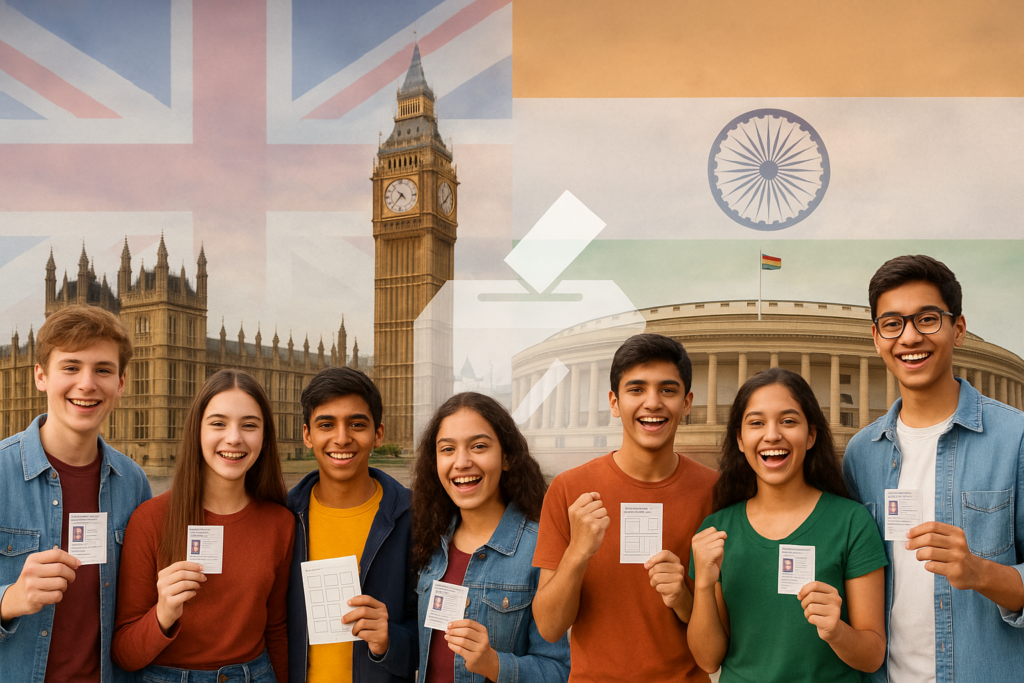
- On 17 July 2025, the United Kingdom introduced a historic electoral reform by lowering the voting age from 18 to 16 for all UK elections, described as the most significant change to its democratic system since the Representation of the People Act 1969, which reduced the voting age from 21 to 18.
- The 61st Constitutional Amendment Act, 1988, reduced the voting age from 21 to 18, as people were starting to be politically aware, despite being a turbulent phase both economically and socially.
- Lowering the voting age could enhance the voices of marginalised youth: those from the countryside, and youngsters from a lower socio-economic background, who say they feel disconnected from politics.
- A cautious, evidence-based approach beginning with local elections, a portfolio that poses the fewest risks, could unleash the power of India’s youth and also address concerns about maturity and logistics.
Introduction
On 17 July 2025, the United Kingdom introduced a historic electoral reform by lowering the voting age from 18 to 16 for all UK elections, described as the most significant change to its democratic system since the Representation of the People Act 1969, which reduced the voting age from 21 to 18. The move, which coincides with existing policies in Scotland and Wales where 16 and 17-year-olds can already vote in devolved elections, is part of a drive to increase faith in democracy and involve younger citizens in politics. With a constituency of 1.5 million new voters in the offing, the UK’s move has raised the debate on the issue, as well as in India, where voting age was last re-visited through the 61st Constitutional Amendment in 1988, reducing it from 21 years to 18. As the world’s biggest democracy, it is now time for India to re-evaluate its electoral architecture in the light of this international drift and determine the pros and cons of reducing the voting age to 16.
Rationale in the UK and Worldwide
The UK government has a fundamentally positive view that reaching out to younger citizens will promote democratic activity. Supporters say 16-year-olds who have responsibilities such as paying taxes, giving or refusing consent to medical treatment and joining the armed forces are mature enough to take part in elections. The move is modelled on successful examples in Scotland and Wales, where 16- and 17-year-olds have been able to vote in local and regional elections since 2015 and 2020, respectively. A further argument was also made in the aftermath of the 2014 Scottish independence referendum, in which teenagers voted in large numbers, that if young people start voting at an early age, it will encourage them to stay engaged later in life.
Around the world, countries including Austria, Malta and parts of Germany already permit 16-year-olds to vote in some elections, and “the evidence shows that when younger demographics are given the vote, they participate in larger numbers”. The UK’s reform, however, is not without its critics. Detractors, including some in the commentaries on platforms like X, argue that 16-year-olds cannot be politically responsible and mature voters, thereby undermining rather than bolstering democracy. Others see it as a progressive development because youths are more politically engaged, fueled by issues such as climate change, fair social practices and digital rights.
Indian Precedent: The 61st Amendment Act, 1988
There is a parallel in India’s own experience with voting age reform. The 61st Constitutional Amendment Act, 1988, reduced the voting age from 21 to 18, as people were starting to be politically aware, despite being a turbulent phase both economically and socially. This transformation expanded the electorate by millions, giving a generation a say in India’s democratic future. But whether to lower the voting age even more, to 16, has not gone far, though it is discussed sporadically. A 2023 Parliamentary Standing Committee report recommended that the minimum age for contesting Lok Sabha and Assembly elections be brought down from 25 to 18, in line with global trends and following mounting global attention to youth movements such as ‘Fridays for Future’. However, the Election Commission of India (ECI) has refused, contending that even 18-year-olds may not be mature enough for such responsibilities, let alone 16-year-olds.
Why Should the Voting Age be Reduced in India?
India’s youth, constituting over 50% of the population out of 1.4 billion population is a demographic force. Their voices must be heard in a democracy where education, jobs and climate change have had a direct bearing on their future and require immediate attention. The UK’s decision echoes several arguments relevant in India’s context:
i. Youth Engagement and Political Awareness: Indian youth are becoming more assertive, whether protesting climate change or advocating for digital privacy and jobs. On social media platforms like X, young Indians are seen debating politics with pointed comments about the state of governance. Reducing the voting age would channel this energy into the formal democratic system, minimise the phenominimise apathy and increase the voting percentage, which stood at just 67.4% in the 2024 parliamentary elections.
ii. Global Precedents and Local Successes: The UK reform is in line with global trends, and India can gain insights from countries and make use of lessons from states such as Kerala, where the youth-driven initiatives have had an impact on local governance. Enfranchising 16-year-olds in local elections, as some X users propose, could be one strategy, using school enrolment records to register them to vote.
iii. Empowering Marginalised Voices: Lowering the voting age could enhance the voices of marginalised youth: those from the countryside, and youngsters from a lower socio-economic background, who say they feel disconnected from politics. Automatic voter registration, as the UK has proposed, would help make a broader electorate more inclusive.
Challenges and Counterarguments

But there are significant roadblocks to reducing the voting age in India. But the ECI’s position is indicative of larger anxiety regarding political maturity. Critics counter that 16-year-olds, who are still in school, could be swayed by populist rhetoric or pressured by the press and are not mature enough to make an informed choice. Risks around India’s complex and polarised politics, such as problems like the spread of misinformation on platforms like Facebook and WhatsApp, could amplify those risks.
Logistical challenges are also daunting. India’s electoral rolls are already rife with inaccuracies, and the addition of millions of new voters would further burden the system. Only 464,000 of the cohorts of 800,000 newly enfranchised 18- to 20-year-olds registered in the UK at the 1969 reform, highlighting the space between enfranchisement and participation in reality. India, with lower literacy rates and unequal access to civic education, particularly in rural areas, may even have lower registration and turnout among 16 and 17-year-olds.
In addition, political factions could prey on young voters by offering them benefits in the short term rather than approaching the underlying systemic problems. Lok Sabha polls presented an application of the fact that welfare and schemes have a huge say in the voting behaviour, and the youth votes specifically might be especially influenced in this effort.
A Balanced Path Forward for India
India doesn’t have to follow blanket reduction, unlike the UK, but it can stagger the phased manner. A pilot project giving local election voting rights to 16-year-olds, as proposed on X, would be a good experiment. “Schools could become voter registration centres and play a role in civic education to expose young voters to the act of voting”. Enhancing digital literacy and critical thinking through curricula would enable them to navigate misinformation, increasingly a problem in India as well as in the UK.
The UK also provides a lesson highlighting the value of cross-party agreement. In India, where electoral reforms tend to be met with political resistance, generating bipartisan support would be essential. The 2023 Parliamentary panel’s apparent drive to bring down the age of contesting elections indicates some receptivity to youth-oriented reforms, a mindset that could be further embraced for debates on voting age.
Conclusion
The UK’s move to reduce the voting age to 16 offers India an opportunity to relook at voting rights, balancing youth inclusion with practical challenges. Though the 61st Amendment was a milestone in 1988, it’s the right time to reconsider the voting age, given India’s young demographic and global trends. A cautious, evidence-based approach beginning with local elections, a portfolio that poses the fewest risks, could unleash the power of India’s youth and also address concerns about maturity and logistics. As the world’s largest democracy, India has the chance to model for the rest of the world that the youngest citizens should stand not as mere spectators, but as architects of its future. For the time being, however, the UK’s step is a ferment for discussion. It presses India to manage ambitious reform with practical caution.
References:
- 1. https://www.legislation.gov.uk/uksi/1969/630/pdfs/uksi_19690630_en.pdf
- 2. https://commonslibrary.parliament.uk/research-briefings/sn01747/
- 3. https://gulfnews.com/world/europe/uk-to-lower-voting-age-to-16-in-landmark-move-to-boost-participation-1.500201763?utm_source=chatgpt.com
- 4. https://www.india.gov.in/my-government/constitution-India/amendments/constitution-india-sixty-first-amendment-act-1988
- 5. https://mospi.gov.in/sites/default/files/publication_reports/Youth_in_India_2022.pdf
Dr. Kavita Lalchandani is the Principal of K.C. Law College, Mumbai, and Megna Devkar is a Ph.D. Research Scholar at K.C. Law College, Mumbai. Views expressed are the author’s own.
